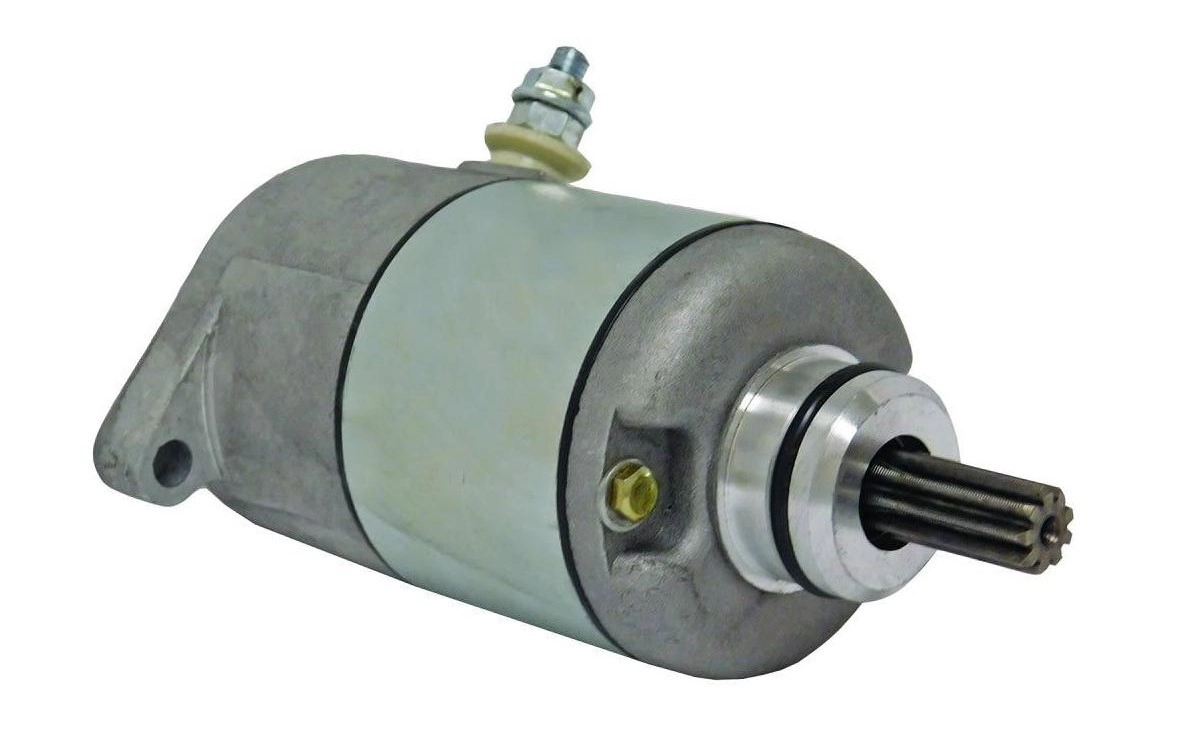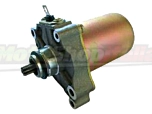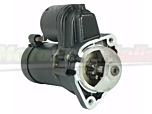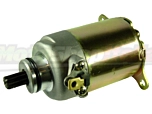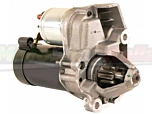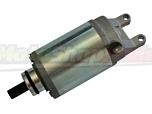The starter motor is a fundamental component, often not given due attention in our motorcycles. This small yet powerful element is vital for the vehicle's operation. Imagine a winter morning, you're in a hurry, and your motorcycle doesn't respond. You turn the key, but silence prevails. At that moment, its importance becomes evident.
This device is the catalyst for the engine's startup. Without this motor, even the most robust and modern engine remains inert. It transforms the motorcycle battery's electrical energy into mechanical motion, bringing the engine to life.
Consider a common situation: a stop during a journey. You take a brief break in a remote location. Upon returning, the motorcycle won't start. A non-functioning starter motor means being stranded, emphasizing its importance for your freedom of movement.
Another aspect to consider is efficiency. A well-maintained starter motor ensures a quick start and reduces stress on the battery. This not only saves you time but also protects other electronic components of the motorcycle. A faulty motor can cause difficult starts, consuming more energy and shortening the battery's life.
In summary, the starter motor is more than just a mechanical piece. It is a key element that ensures your motorcycle is always ready for use. Taking care of it means ensuring trouble-free starts, protecting the battery, and keeping the motorcycle in optimal condition. Do not underestimate its role: an efficient starter motor is essential for a journey without inconveniences.
Signs of a Faulty Motorcycle Starter Motor
Identifying a fault in the motorcycle's starter motor is crucial to prevent major problems. The signs can be subtle, but recognizing them promptly makes a difference.
Here are some key clues:
- Difficulty in starting: This is the most evident sign. You turn the key, and the motorcycle struggles to start or doesn't start at all. This can happen suddenly or gradually.
- Unusual noises: When attempting to start the motorcycle, you hear clicks or grinding noises. These sounds are indicators of a motor struggling to engage or that is damaged.
- Dead battery: If the battery is charged but the motorcycle doesn't start, the problem might be in the motor. An apparently dead battery can be a false signal caused by a faulty motor.
- Burning smells: A pungent burning odor is an alarm signal. It could indicate the motor overheating or an internal short circuit.
- Interruptions during starting: The motorcycle begins to start but suddenly stops. This can indicate an intermittent problem in the motor.
- Dashboard warning lights: Some motorcycles have warning lights that illuminate when there's a problem with the starting system.
Imagine this situation: you're ready for a motorcycle ride, but when you turn the key, you hear only a faint click, and nothing moves. Or, after several attempts, the motorcycle starts but with a slow and laborious start. These are clear signs that something is wrong with the starter motor.
Paying attention to these signs is crucial. Timely intervention can save you from costly repairs and ensure your motorcycle is always ready for use. Always remember this, a well-maintained starter motor is the key to a smooth adventure on the road.
Steps to Diagnose a Faulty Motorcycle Starter Motor
Diagnosing a fault in the motorcycle's starter motor is a crucial step to ensure your vehicle is always ready for use.
Here's a step-by-step guide to identify the problem:
- Check the battery: Start by checking the battery. Is it charged? Are the terminals clean and well connected? A dead battery or poor connections can simulate a motor fault.
- Listen to the sounds: When attempting to start the motorcycle, listen carefully. A single click may indicate a problem in the motor, while continuous noise could be a sign of a dead battery.
- Observe the lights: Turn on the ignition and watch the dashboard lights. If they don't light up or are weak, it could be a sign of electrical problems affecting the motor.
- Try pushing the motorcycle: In some cases, pushing the motorcycle can help understand if the problem is in the motor. If the motorcycle starts easily by pushing, the motor might be the culprit.
- Inspect electrical connections: Check the motor's cables and connections. Look for signs of wear, corrosion, or looseness. A damaged cable can disrupt the current flow.
- Listen to the motor: If possible, listen directly to the sound of the motor during an attempt to start. A weak sound or no sound can indicate an internal fault.
- Check the starting relay: The starting relay can be another source of problems. If it's faulty, the motor won't receive power.
- Consult a mechanic: If you're unsure or if the previous steps haven't identified the problem, it's time to consult a professional. An experienced mechanic can make more thorough diagnoses.
Remember, the correct diagnosis is essential for effective repair. Take the time to perform these steps carefully. A functioning starter motor is essential to ensure your motorcycle is always ready for adventure.
Overview of Costs: The Expense of Changing a Motorcycle's Starter Motor
Changing the starter motor in a motorcycle involves various costs. These can vary significantly based on several factors. Here's an overview:
- Cost of the replacement part: Prices for starter motors on our site can range from about 19 euros to 500 euros. This wide range depends on the specific model of the motorcycle and the quality of the replacement part.
- Labor costs: The replacement requires the intervention of a mechanic. The cost of labor can vary depending on the complexity of the job and the mechanic's hourly rate. Of course, if you decide to do it yourself, you won't pay labor costs.
- Model of the motorcycle: Motorcycles of different brands and models may require specific starter motors. More rare or luxury models might have more expensive replacement parts.
- Availability of spare parts: The availability of spare parts affects the price. Hard-to-find or imported parts can increase the cost.
- Quality of components: There are original and compatible spare parts. Original parts tend to be more expensive but often offer greater reliability.
- Urgency of the repair: If you need an urgent repair, you might have to pay more for quick service.
On average, considering both the cost of the part and labor, replacing the starter motor can cost between 300 and 500 euros. However, this is only an indicative value. The final price will depend on the factors mentioned above.
For example, if you own a common motorcycle, you might find a starter motor at a lower price and pay less for labor. On the other hand, if your motorcycle is a rare or high-end model, the cost of parts and labor could be significantly higher.
Thus, the cost to change the starter motor varies based on different factors. We recommend considering the option of compatible spare parts to reduce expenses.
Detailed Procedure for Replacing the Starter Motor
Replacing the motorcycle's starter motor is an operation that requires precision and attention.
The points below explain how to proceed:
Necessary tools:
- Socket wrench set.
- Screwdriver.
- Pliers.
- Battery tester.
- Work light.
Key steps:
- Safety first: Ensure that the motorcycle is off and in a stable position. Disconnect the negative terminal of the battery to avoid short circuits.
- Locate the starter motor: Depending on the model of the motorcycle, the starter motor is usually located near the engine. Refer to your motorcycle's manual for the exact location.
- Remove components obstructing access: In some cases, you might need to remove parts like the fuel tank or fairings to access the starter motor.
- Disconnect the starter motor: Use pliers to remove the cables connected to the motor. Be careful to remember where each cable was connected.
- Remove the starter motor: Use the socket wrench to unscrew the bolts that secure the motor. Handle carefully to avoid damaging other parts.
- Compare the old and new motors: Before installing the new motor, compare it with the old one to ensure they are identical.
- Install the new motor: Position the new motor and secure it with the bolts. Ensure it is firmly attached.
- Reconnect the cables: Reconnect the cables to the new motor. Ensure each connection is secure.
- Test the motor: Before reassembling all the parts, test the motor. Reconnect the negative terminal of the battery and try to start the motorcycle.
- Reassemble removed parts: If everything works correctly, reassemble the parts you had removed.
Tips for Maintaining the Starter Motor to Prevent Future Failures
Maintaining the starter motor is essential to ensure a long life for your motorcycle and prevent failures. Here are some practical tips:
- Regularly check the battery: A battery in good condition is crucial for the proper functioning of the starter motor. Periodically check the charge level and cleanliness of the terminals.
- Inspect electrical cables: Ensure the motor's cables are always well secured and without signs of wear. Damaged cables can cause starting problems.
- Avoid frequent and short starts: Each start puts strain on the motor. Limit short and unnecessary starts to reduce wear.
- Keep the motor clean: Dust and dirt can accumulate and cause problems. Periodic cleaning helps to keep the motor in good condition.
- Listen to the motor's sounds: If you notice unusual noises during starting, it could be a sign of wear. Do not ignore these signs.
- Protect the motorcycle from the elements: Exposure to rain, humidity, and extreme temperatures can damage the motor. If possible, park the motorcycle in a covered place.
- Check the starting system: A periodic check of the starting system by a mechanic can prevent future problems.
- Do not force the start: If the motorcycle doesn't start, do not insist with repeated attempts. This can overheat and damage the motor.
- Replace the motor if necessary: Do not wait for the motor to completely fail. If it shows obvious signs of wear, consider replacement.
- Consult the motorcycle manual: Follow the manufacturer's recommendations for maintaining the starter motor.
Differences Between Starter Motors in Motorcycles, Scooters, Cars, and Hybrid Vehicles
In the world of vehicles, the starter motor plays a fundamental role, but it varies considerably among motorcycles, scooters, cars, and hybrid vehicles. Each type has its peculiarities:
- Motorcycles: In a motorcycle, the starter motor is designed to be compact and efficient. It needs to quickly start the engine, often with a high compression ratio, without adding too much weight to the vehicle.
- Scooters: Scooters, especially the smaller ones, have even more reduced starter motors in size. They are optimized for less powerful engines, ensuring smooth starts without requiring much energy.
- Cars: In cars, the starter motor takes on a more robust form. It must handle larger engines and often operates in more demanding conditions, like intense cold or extreme heat.
- Hybrid Vehicles: Here we encounter true innovation. The starter in a hybrid vehicle not only starts the engine but also acts as a generator. This dual function requires advanced design for efficiency and durability.
Think, for example, of the difference between starting a sports motorcycle and a family car. The motorcycle requires a quick and powerful impulse, while the car needs a starter motor that can handle a more substantial workload.
Similarly, compare a scooter with a hybrid vehicle. The scooter relies on a simple and direct system, while the hybrid uses more complex technologies to meet different needs.
The starter motor adapts to the specific needs of each type of vehicle. These differences reflect the various requirements of power, size, and functionality demanded by different engines. Understanding these variations is essential for keeping every vehicle in perfect efficiency.
Conclusion: The Importance of a Functioning Starter Motor
Understanding the importance of an efficient starter motor is like realizing the value of a good start: essential for the success of what follows. It's the difference between starting on the right foot or being stuck before even beginning.
Think of those cold winter mornings when every minute counts. You're ready to go, but your motorcycle remains immobile, silent. At that moment, a non-functioning starter motor is not just a setback but the first step towards a day full of complications.
Safety, especially when traveling, is never a detail. A faulty starter can turn into a serious problem, especially if you are far from home or in isolated areas.
Having a starter motor you can rely on gives you that peace of mind that is priceless.
From an economic perspective, a well-maintained starter motor is a real investment. Prevention is always better than cure: regular maintenance can save you from much higher expenses in the future. Every time you press the start button, it's as if you're entrusting your journey to this small, but essential, component.
And let's not forget how an efficient starter motor helps preserve the health of the entire motorcycle. A smooth and trouble-free start reduces stress on the battery and electrical system, extending their life.
In short, the starter motor is not just a piece of metal hidden under the tank. It's the key that starts every two-wheeled adventure. Taking care of it means ensuring worry-free starts and safe, enjoyable journeys. A functioning starter motor is not just a technical detail: it's the certainty that, every time you turn the key, a new adventure is about to begin.

 Italiano
Italiano
